July 24, 2009
Air Date: July 24, 2009
FULL SHOW
SEGMENTS
The U.S. Pushes India to Adopt Carbon Limits
View the page for this story
U.S. Secretary of State Hillary Clinton met with Indian minister of environment and forests, Jairam Ramesh, to talk about climate change. The U.S. wants India to implement binding limits on carbon emissions. But that doesn’t sit well with Mr. Ramesh who countered that India’s per capita CO2 emissions are among the lowest in the world and that developed nations like the United States should set an example by reducing their emissions before asking developing nations to follow suit. Host Jeff Young talks with William Antholis, the managing director of the Brookings Institution about Secretary Clinton’s trip to India. (06:40)
The China Challenge
View the page for this story
Among the developing countries reluctant to reduce greenhouse gas emission before developed countries make progress, China is the economic powerhouse. U.S. labor and industry groups worry capping emissions at home while China goes about its business as usual will put the United States at a competitive disadvantage. Commerce Secretary Gary Locke just returned from China. He tells host Jeff Young when it comes to climate change and trade with China, there are just as many opportunities as there are challenges. (05:30)
Saving the Cypress
/ Andrew StelzerView the page for this story
Gardeners and landscapers use cypress mulch to minimize weeds and keep moisture in the soil. But cypress trees are important storm barriers on the Gulf Coast. As Andrew Stelzer reports from Louisiana, there’s a growing movement to prevent these vital trees from being relegated to mulch. (09:15)
Watch Your Water
/ Lisa SongView the page for this story
A new device tracks water use throughout your home and as Living on Earth’s Lisa Song reports, is designed to help you conserve. (01:55)
Cracking the Hard Rock Mining Law
View the page for this story
The hard rock mining law of 1872 was written during the Civil War to encourage development in the West. But more than 100 years later, mining companies can still dig up uranium, gold, and other minerals on public lands without paying royalties and without cleaning up. The Interior Department just placed a ban on new mining claims near the Grand Canyon. Arizona Congressman Raul Grijalva talks with host Jeff Young about his proposed legislation to make the ban permanent and about reforming the hard rock mining law of 1872. (06:45)
Conservation Refugees
View the page for this story
Indigenous peoples are sometimes kicked off of their land to make way for national parks and reserves for charismatic wildlife. They essentially become refugees in the name of conservation, says author and environmental journalist Mark Dowie. Dowie talks with Steve Curwood about his new book, Conservation Refugees: The Hundred-Year Conflict between Global Conservation and Native Peoples. (10:40)
Dandy Dandelions
/ Laurie SandersView the page for this story
Dandelions are often dismissed as a lowly weed. But plant biologist Joan Edwards sees the flower as an amazing engineering marvel. Producer Laurie Sanders took to the lawns of Williams College with Edwards to find out more about the virtues of dandelions. (05:30)
Show Credits and Funders
Show Transcript
Host: Jeff Young, Steve Curwood
Guests: William Antholis, Mark Dowie, Congressman Raul Grijalva, Gary Locke
Reporters: Laurie Sanders, Andrew Stelzer
Note: Lisa Song
[THEME]
YOUNG: From Public Radio International - this is Living on Earth.
[THEME]
YOUNG: I’m Jeff Young.
A passage to India – Secretary of State Hillary Clinton looks for co-operation there on cutting greenhouse gases.
CLINTON: So climate change would not be solved even if developed countries stopped emitting greenhouse gas emissions today—unless action is taken across the world. So, we have to work together.
YOUNG: But did her message curry favor?
And back here at home, how your garden mulch could do much harm to the Gulf Coast.
HYDE: Not only do the Cypress Forests help break the storm surge, but they absorb a lot of the power of the wind force of the storms. And with that region now denuded, we are seeing the storms coming in with extraordinarily far greater violence.
YOUNG: Saving the cypress swamps – plus learning to love a backyard weed, the dandelion.
That and more - this week on Living on Earth! So stick around.
The U.S. Pushes India to Adopt Carbon Limits
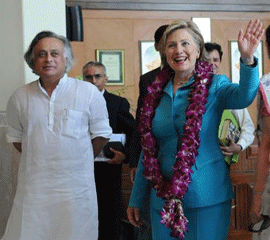
(Courtesy of the State Department)
YOUNG: From the Jennifer and Ted Stanley studios in Somerville, Massachusetts, this is Living on Earth. I’m Jeff Young.
To reach an international agreement on climate change, negotiators must bridge the chasm between rich nations and developing ones. The path to a truly global, global warming pact goes through emerging economies like China and India. And top US officials were blazing trails there recently.
The commerce and energy secretaries traveled to China, and Secretary of State Hillary Clinton talked climate change in India. We’ll hear from the commerce secretary in just a bit.
But first, Clinton’s trip to India. Secretary Clinton told Indian officials the US will do its part but Indian emissions matter, too.
CLINTON: India’s own greenhouse gas pollution is projected to grow about 50 percent between now and 2030. So climate change would not be solved even if developed countries stopped emitting greenhouse gas emissions today—unless action is taken across the world. So, we have to work together.
YOUNG: It’s not clear how well her message got across. So we asked Brookings Institution Managing Director William Antholis for an assessment.
ANTHOLIS: I think in general the trip was a big success. And it’s important to view this meeting as the beginning of a process and a dialogue that leads up as an important milestone to the Copenhagen meeting in December. But even that is just one step along the way and the fact that she listed climate change as a priority and got at least behind the scenes a cooperative spirit from the Indians I think was a success.
YOUNG: She did run into some push back pretty publicly from India’s environment administer, Mr. Ramesh, who told Secretary Clinton very publicly that India should not have to reduce emissions. Here’s what he said, “There’s simply no case for the pressure that we who have among the lowest emissions per capita face to actually reduce emissions.” What do you make of that argument?
ANTHOLIS: Well, I think that the core of the argument is a good one. In broad sense, there wouldn’t be much disagreement with the core of Jairam Ramesh’s statement. India’s per capita emissions are, compared to the United States, really quite small. And I don’t think anyone is looking for India to act at the same level, in the same timescale as the United States. And so in that sense, there’s a bit of a false fight there. The bigger fight is over where we’re going over the next 35 years, and at what point India might take on binding targets and what level those binding targets should be.
YOUNG: You point out that there’s also some responsibility here for reigning in population.
ANTHOLIS: Well, what the India’s want is a per capita emission standard that applies to all countries equally. So say that that target was four tons of emissions per person. In the United States, we would have to cut our emissions by about 80 percent. India’s per capita emissions right now are about two tons per person, so they would be able to double per person. But here’s the catch, if India’s population doubles between now and 2050, that’s twice as many emissions, even though their emissions per person would be the same. So, a per capita emission standard by itself may not solve the problems.
YOUNG: So do we see indications from India that they’re willing to say we need to control population as well?
ANTHOLIS: Population control has not been brought up as part of the climate change talks. And I think the way that people will try to address it is not to say population control needs to be part of climate change, but rather our climate change benchmarks need to have a number of different factors, one of which is per capita emissions. But that by itself can’t be a freestanding thing. The Indians haven’t yet acknowledged that.
My expectation is in the negotiations as they come forward and as we try to establish targets for 2050, the targets will have a number of different elements. One will be the total amount of emissions per country and as a globe. Two will be the global temperature itself. And then finally, per capita I think will be part of the final equation, but not by itself as a standard but one that incorporates these other concerns.
YOUNG: So what’s the effect back home when say members of the Senate who are about to consider an energy and climate change bill watch Secretary Clinton taking this trip and what was said. Does it will or hurt the effort to get a bill through the Senate?
ANTHOLIS: It definitely helps to see Secretary Clinton making this a priority in her conversations. But what they want to know is that U.S. companies are not going to be hurt when a comprehensive cap and trade bill is passed and that the emissions that we cut at home aren’t simply going to happen someplace else, particularly in big emerging developing countries.

Secretary of State, Hillary Clinton with Jairam Ramesh, the Indian minister of environment and forests. (Courtesy of the State Department)
ANTHOLIS: I think we really did. First Jairam Ramesh – this is a key political strategist in the Congress party and had been for years. He’s an astute politicians who understands politics in the United States as well as in India. But he’s really an India political operative at heart. And he knows that in a country where four or five hundred million people are living at the poverty line, that doing something precipitous on climate change is really dangerous politics.
YOUNG: Is there a broad awareness, though, that India faces great risks from climate change?
ANTHOLIS: Well, the Indian political leadership certainly have taken notice. First of all the leader of the UN scientific effort which one the Nobel Prize along with Al Gore several years ago is an India.
YOUNG: Right.
ANTHOLIS: Dr. Pachauri. And he was been a very outspoken proponent of fast action in India on climate change, not just for the global commons, but for India. India probably would suffer greater per person from the ravages of climate change than any other country in the world. But India is a country because of the high tech revolution that really could benefit from fast developments in solar and other renewable energy, not to mention nuclear. So India potentially has a real upside on this, and India leadership is paying careful attention to that. The idea that climate change is something that is in India’s broad interest, I’m not sure has reached the broad public in India in quite the way that it has in Europe and increasingly in the United States.
YOUNG: William Antholis is managing director of the Brookings Institution. He’s been talking to us about Secretary Clinton’s recent trip to India. Thanks for your time.
ANTHOLIS: You’re welcome.
Related links:
- The Brookings Institution on India and climate change.
- For more about Clinton’s India trip, click here.
The China Challenge
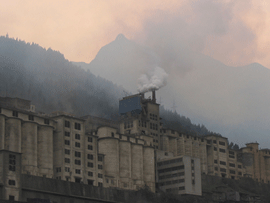
A coal-burning concrete plant near the Yangtze River. China as a whole is now the world’s biggest emitter, but U.S. per capita emissions are five times those of the Chinese. (Photo: David Dewey)
YOUNG: Now Secretary Clinton wasn’t the only cabinet member in Asia. Commerce Secretary Gary Locke, the first Chinese-American to hold that post, joined energy Secretary Stephen Chu on a week-long tour of green technology sites in China.
And Secretary Locke is on the line with us now, thanks for joining us.
LOCKE: My pleasure Jeff.
YOUNG: I want to hear about this trip to China. You know we hear some many mixed signals on where China is headed with energy. We hear they’re racing ahead on clean energy investment. Oh no, they’re building a dirty coal power plant every week. Well, which is it?

Solar panels in Kunming. China wants a fifth of its energy demand to come from renewables by 2020. (Photo: Matthijs Koster)
YOUNG: Now one thing you emphasized on the trip was the importance of sharing energy technology. How does that benefit China? How does that benefit the U.S?
LOCKE: Well clearly there are great opportunities for collaboration. Secretary Chu and the Chinese were able to announce a joint scientific endeavor in which both countries will contribute about $7.5 million each to create a joint research center. This is an opportunity where the intellectual property would be owned by both and therefore we could share it with the whole world in fact.
And we visited quite a few places that show the incredible potential of clean energy technologies. And interestingly enough two of those featured American made products. There’s a U.S. company that’s producing the most advanced clean burning diesel bus engines. In fact, they’re working on technology where the air coming out at the end of the tailpipe will actually be cleaner than the air going into the engine. So these are examples of win-win opportunities.
YOUNG: Now I know some U.S. business interests have expressed some concern about sharing technology, energy technology, around this area of intellectual property rights and, you know, keeping our competitive energy. How do we remain the leaders in clean energy technology if we’re sharing this with our chief competitors?
LOCKE: Well that’s why it’s very, very important that we also pursue intellectual property rights protections and make sure that U.S. companies are able to sell their products and services in China and that whatever technologies they introduce into China is not copied and ripped off. Progress is being made of course the U.S. believe that more progress must be made and faster. But we simply can not wait for the Chinese to develop their own domestic industries on alternative energy cause every year that we wait, it makes it even harder to reverse the effects of climate change.
YOUNG: Do these concerns about getting the clean energy in time to meet the climate challenge trump concerns about intellectual property rights and competitiveness?
LOCKE: I don’t see those as mutually exclusive. The Chinese leaders have indicated that they are willing to pay for the technology. They’d like us to share more. There is just so much to be done. And U.S. companies are saying that they’re able to sell their technology. They’d like to sell more of course. And we need to fight protectionism within China that might favor domestic companies. That is the biggest hurdle that American companies face. It’s the fact that they’re being shut out from some of these bidding opportunities to build a clean power plant. And that the Chinese might be favoring just Chinese companies.
YOUNG: Now, a pretty big chunk of China’s emissions come from the manufacture of goods that primarily we buy here in the U.S.
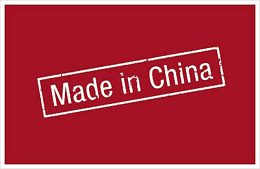
About a third of China’s heat-trapping gases come from export production for Western countries.
LOCKE: Well, first of all the Chinese certainly have the funds to help those companies clean up their act and I‘ve always believe that quite frankly – because we embrace these environmental standards along w with health and human safety standards and worker’s rights and labor standards. It really puts American companies at a competitive disadvantage because those goods can be produced at a cheaper cost which makes buying those goods much more attractive than goods made in America.
YOUNG: But do we bear no responsibility for our consumption? I men, we are the ones a lot of those goods that the Chinese manufacture simply for export.
LOCKE: Well that’s why I think out trade agreements need to incorporate these basic minimum standards of human rights, health and safety standards, environmental regulations and I believe that they should incorporate standards that address climate change as well.
YOUNG: You’re the first Chinese-American to be our secretary of commerce and you’re traveling partner on this trip to China, Steven Chu, also Chinese-American. I’ve wondering how did that affect your reception there in China and your ability to build relationships with the Chinese?

Commerce Secretary Gary Locke.
YOUNG: U.S. Commerce Secretary Gary Locke reporting on his recent trip to China. Thank you for your time, Sir.
LOCKE: Well thank you very much Jeff.
YOUNG: Coming up: it might help your garden grow but cypress mulch could be eating away at Louisiana swamps. Keep listening to Living on Earth.
Related links:
- Click here to find out more about clean tech and intellectual property.
- Learn more about China’s renewable energy goals.
- Learn more about how Western demand for Chinese products plays a role in China’s greenhouse gas emissions.
- Read Secretary Locke’s speech in Beijing
[MUSIC: Tom Verlaine “Please Keep Going” from Warm And Cool (Thrill Records 2006)]
Saving the Cypress
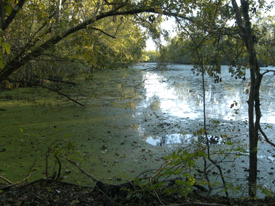
(Photo: Andrew Stelzer)
YOUNG: It’s Living on Earth – I’m Jeff Young.
More Americans are scrubbing those black crescent moons of soil from under their fingernails. Backyard gardens are making a comeback.
And that means more business at the garden store for soft feathery mulch, much of it made from ground up cypress. Mulch keeps weeds down and the soil moist. But mulch from cypress could have some unintended consequences.
Cypress trees, some of them ancient giants, form an important storm barrier on the Gulf Coast. Now there’s a move to stop the sale of fiber from those trees. From Louisiana, Andrew Stelzer has the story.
[SOUND OF WALKING IN FOREST, DOGS PANTING]
STELZER: Dean Wilson and his two dogs are rambling through the dense Louisiana swampland about 100 miles west of New Orleans. Wilson is originally from Spain; he fell in love with the swamp 25 years ago and never left. He lives out here in a wooden cabin, on the edges of the Atchafalaya River Basin.
WILSON: Some people call it like going into a fairytale. Its like an enchanted forest, they call it. It's unbelievable. They just can't believe how beautiful it is.
STELZER: We’re surrounded by twisted, gnarled cypress trees and shallow bogs filled with alligators. It’s the largest swamp in the United States; more than 1.4 million acres. But this forest isn’t what it once was.
WILSON: There was a tree here, an ancient tree. It was pretty big. It went all the way from here to right there at or about 6 feet in diameter.
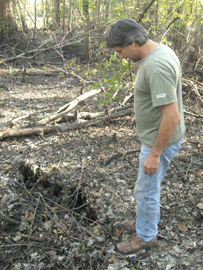
Dean Wilson looks at a depression in the ground where a Cypress tree used to be. (Courtesy of Andrew Stelzer)
HYDE: And we believe that that's because of the destruction of the cypress forest.
STELZER: Dr. Samuel Hyde is a Professor of History at Southeast Louisiana University.
HYDE: Not only do the cypress forests help break the storm surge, but they absorb a lot of the power of the wind force of the storms. And with that region now denuded, we are seeing the storms coming in with extraordinarily far greater violence that they did when the forests were there.
STELZER: There’s always been a demand for cypress lumber; it’s strong, smells good, doesn’t swell when wet, and is naturally insect-resistant. But over the last 25 years, there’s been a tremendous rise in the logging of cypress trees not for construction, but for garden mulch.
CORBITT AD: Well, make sure when you start setting in your flower beds trying to make it pretty, don’t use imitation mulch. Make sure its no-float professional cypress mulch. Here’s why. …
STELZER: That’s the on-hold phone message at Corbitt Manufacturing, a Florida based company that’s one of the biggest cypress mulch producers in the country. Corbitt wouldn’t be interviewed for this story, but has defended its practices as environmentally sound.
CORBITT AD: … and did you know—there are more cypress trees today than there were ten years ago? Cypress trees are a natural reproducer…”
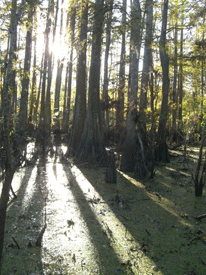
Near the Atchafalaya Basin(Courtesy of Andrew Stelzer)
WILSON: So we followed the trucks from the logging sites, and this truck in particular, when I followed the truck. I took a lot of pictures, so there's no doubt that the truck went from point A to point B.
STELZER: Wilson followed a truck full of cypress logs, which ended up at a Louisiana wood products mill. He couldn’t get inside, so an airplane pilot volunteered to fly him over the mill to take pictures.
WILSON: You can see all the cypress from the air. There are whole trees waiting to be mulch.
STELZER: He photographed cypress trees in front of a grinder, a pile of mulch on the other side, and bags of cypress mulch, labeled as Corbitt’s ‘No-Float’ brand all on the property. Wilson saw similar evidence of trees being ground into mulch when he photographed other mills.
WILSON: We never, ever have seen a truck full of branches and treetops. We flew over the plants, we've never seen a pile of treetops and branches anywhere. That’s not true.
STELZER: Most cypress mulch is sold at major retailers like Wal-Mart, Home Depot, and Lowe’s. Dean Wilson called them to let them know what he was finding. Wal-Mart responded immediately; company officials came down to take their own look around, and in 2008, the superstore chain stopped selling any mulch harvested, bagged, or manufactured in the state of Louisiana. But Wilson soon found one mulch producer in Louisiana was labeling its mulch as coming from Florida.
WILSON: We could not see the nametag, but we have high pixel cameras very good cameras, so we magnified the picture…and look how good you can see the names on the bags. Florida Gold, same company. Corbitt.
STELZER: Another company bagging mulch in Louisiana labeled it as coming from Arkansas. Still another plant was grinding up full cypress trees, then labeling the bags as “forest friendly, one hundred percent sawmill byproduct.” What Wilson found makes it hard for anyone, people or stores, to know what they’re really buying.
WILSON: You find these bags, and they guarantee those people that it's all sustainable. The reality is, this mulch here was coming from a clear-cut, I can show you the pictures— in the middle of the Atchafalaya Basin. That is not sustainable.
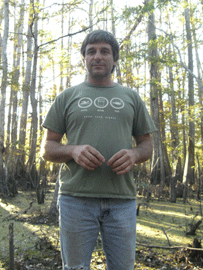
Dean Wilson near his house in Bayou Sorrel, on the edge of the Atchafalaya Basin. (Courtesy of Andrew Stelzer)
VANDERSTEEN: Whatever we will harvest, we want to be sure is prepared for regeneration for the next generation.
STELZER: C. A. Buck Vandersteen is the executive director of The Louisiana Forestry Association, an industry group representing loggers, landowners, and forest product producers. He says his members are suffering; at least seven cypress mills in coastal Louisiana have closed, and more jobs will likely be lost.
VANDERSTEEN: Wal-Mart never consulted with us before making this decision to pull out of Louisiana’s cypress market. Had they done that, we would have been able to show them how we manage these lands for sustainable management.
STELZER: With Wal-Mart’s move away from Louisiana cypress, much of the mulch industry, and the debate over it, has shifted to Florida. Dade County banned the products use in new subdivisions. When a county-wide ban was being debated in Polk county, it brought out mulch manufacturers like Brian Mear with the Kemfper Saw Mill. Mear assured the Polk county commission that for him and other producers, the health of cypress forests is a top priority.
MEAR: The real champions of the forest in our state are those who have their living come from it. We have a responsibility to the resource because it’s our income. Guys, it doesn’t make sense for us to go out there and rape and pillage the forest for a dime—we are not that short-sighted.
STELZER: Mulch producers like Mear say that Cypress forests can be replanted; but scientists have found that most of those seeds won’t be able to germinate. Professor Sam Hyde says he doesn’t believe it’s possible to sustainably create cypress mulch, because the trees don’t grow back fast enough, and they are very fragile for the first several years.
HYDE: All you need is a storm surge like Gustav brought last year to get that salt in there again, and all of the work you been doing for the past decade is gone.
STELZER: One solution might be creating an independent body to certify sustainable mulching operations, but as of yet, activists and the logging industry have been unable to sit down at the table together and talk. In the meantime, the Campaign against Cypress Mulch is growing.
[FOREST SOUNDS]
STELZER: Since Wilson began his work, three cities and two parishes in Louisiana have banned the use of cypress mulch on public property. Lowe’s and Home Depot also no longer purchase mulch from Southern Louisiana. He sees these as important successes, but small ones.
WILSON: If we manage to protect the swamps, our great-great-grandkids will be able to see them. We will never be able to see them. It will take that long for them to recover, if they recover at all.
STELZER: More people are becoming aware of the Gulf Coast’s ancient cypress trees. At the same time, cypress mulch is often less expensive that other kinds so demand for it remains strong.
For Living on Earth, I’m Andrew Stelzer, in Bayou Sorrell, Louisiana.
Related links:
- Save Our Cypress Coalition
- Atchafalaya Basinkeeper
- Louisiana Forestry Association on Cypresses
[MUSIC: Dr John: “Save Our Wetlands” from The City That Care Forgot (SLG 2008)]
Watch Your Water

(Photo: Shwetak Patel)
YOUNG: Just ahead – we’ll dig into an antiquated mining law – but first this Note on Emerging Science from Lisa Song.
[SOUND OF WATER GUSHING FROM A FAUCET]
In the heat of summer, droughts bring water rationing and limits on outdoor use. A new household sensor could soon detect every drip coming out of your pipes, making it easier to conserve water.
Professor Shwetak Patel from the University of Washington has invented a gadget that he calls Hydrosense. Like a water filter, it connects directly onto a faucet. A single Hydrosense device can detect water use from anywhere in the house.
It's all about pressure. When you take a shower or brush your teeth, the water pressure goes down in all the pipes, and Hydrosense measures the water flow in gallons per minute. The sensors can even distinguish between different water sources. Each time you turn on a sink, for example, the sudden surge of water sends a small shock wave throughout the pipes in your home. Every single fixture, whether it's the kitchen sink, bathroom sink, or dishwasher--has its own unique shock wave. The sensor uses these differences to monitor water use at various locations.
And what about that dripping faucet? The average American household loses 11,000 gallons of water a year from leaking fixtures. Patel is fine-tuning Hydrosense to find the source of leaks.

(Photo: Shwetak Patel)
That’s this week’s Note on Emerging Science. I’m Lisa Song.
Related links:
- Shwetak Patel's website
- Click here for more information about Hydrosense and Patel's electricity sensors.
Cracking the Hard Rock Mining Law
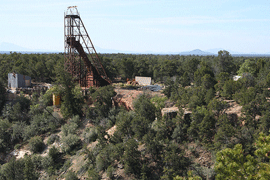
Orphan mine, an adandoned uranium mine below the South Rim at Grand Canyon National Park. There are thousands of new uranium mining claims near the Grand Canyon.(Photo: cogdogblog)
YOUNG: Hardrock mining is getting a closer -- and some say long overdue -- look.
The Obama administration has put a hold on some uranium mining claims near the Grand Canyon. And Congress might reform the law on hardrock mining— a law that’s been largely unchanged since 1872.
[MUSIC: Soundtrack & Theme Orch “The Good The Bad, The Ugly” from Themes In Cinema: Westerns (Countdown Media 2008)]
YOUNG: In 1872 Ulysses S. Grant was president. Mormon leader Brigham Young was arrested for polygamy - 103 wives in case anyone’s counting. And mining in the American west was wild and raw.
MOVIE SOUND: You see in this world, there’s two kinds of people my friend. Those with loaded guns and those who dig. You dig.
YOUNG: Well here to help us sort the good from the bad and the ugly on hardrock mining is Arizona Democrat Raul Grijalva.
Congressman, tell me about uranium mining claims near the Grand Canyon, how many are we talking about here?
GRIJALVA: Well we’re now up to 9000. And this began during the Bush administration where they excluded certain public lands from almost any federal law--excluded them from any real consultation with Native nations. And the consequence has been a rush to judgment. And so all these claims are of a speculative nature. And now we have a vein company and a couple of others that are beginning the drilling for testing and exploration with what they hope is a conclusion to begin to do uranium mining in and around the Grand Canyon.
YOUNG: Now tell me why uranium mining is of special concern and I guess, in telling that story we also have to talk a little bit about that legacy of uranium mining in your state and other western states.
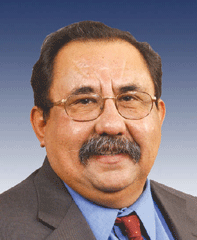
Congressman Raul Grijalva. (Courtesy of the House of Representatives)
YOUNG: In this case is would be the Colorado River, right?
GRIJALVA: Exactly. Which millions upon millions of people in Arizona and Nevada and California are totally dependent on.
YOUNG: Now the Interior Secretary Ken Salazar has done what he calls a two year time-out here, and has withdrawn – what? – roughly a million acres here. Does that resolve the issue?
GRIJALVA: No it doesn’t. I think that the legislation that we’re promoting is a permanent fix of those million acres. A permanent removal from mining claims and mining activity. Period. But this was a vital step that Secretary Salazar took, in the million acres that are being withdrawn, because one of the things is to study intended and unintended consequences of mining. And I think this gives us two years at least to let science and fact dictate what the role should be in these public lands. And I think if we it in the hands of science and fact, we’ll be in good shape. But in the long run I think the permanent removal of those lands is the only solution that we have in front of us.
YOUNG: Now how does all of this relate to the larger effort to change the very old law on hardrock mining which dates back to – what? – 1872, is that right?
GRIJALVA: We wouldn’t be in this mess in the Grand Canyon. We wouldn’t be in this mess in other places across this country if we had reformed the 1872 law a long time ago. When it was put together it was to try to bring some economic development and growth on to the West. Well that’s already occurred. And mining represents less than four percent of the economic reality of the West.
The law of 1872 does not reflect what the West is now and Southwest is now. For example, no royalties. The only extraction activity that pays no royalties is hardrock mining. No royalties at all. No royalties for reclamation, no royalties for cleanup. You know natural gas pays royalties, oil pays royalties. And the centerpiece in this redefinition of mining law is gonna be the royalties and the public process.
YOUNG: Now some of your Republican colleagues counter that “hey, if we don’t get access to the minerals that we have, we’re just gonna put ourselves in a situation of being dependent on a foreign supplier of things like uranium and some of the metals that are essential to electronics engineering and many other products. How do you respond to that?
GRIJALVA: The discussion has never been about shutting the door. It has been about balance. Industry cannot have it their way. They have to understand that in the West people are looking for balance. They’re kinda of tired of the kinda of wide-open atmosphere that has been around for decades.

Orphan mine, an abandoned uranium mine below the South Rim at Grand Canyon National Park. There are thousands of new uranium mining claims near the Grand Canyon. (Photo: cogdogblog)
GRIJALVA: It’s a different process out there. We’re not quite sure what it is.
[LAUGHING]
GRIJALVA: But a lot of good things happen in the House and then end up in some black hole we never see again in the other chamber, this being one of them.
YOUNG: Is this year different?
GRIJALVA: No, it’s not going to be different. But I think the difference is the public. You know we’re in tough economic times and people are gonna have to ask themselves is it right for an industry that is this rich to get things out of the rest of us for free, i.e. hardrock mining. In Arizona, 64 percent of the voter believe those lands should be withdrawn around the Grand Canyon permanently. So using the Grand Canyon as the central symbol we can have a greater influence on the Senate than we have in the past. And I think, you know, the mining interests are very powerful because they’ve had a nice sweetheart deal, no cost deal on our public lands for years.
YOUNG: I’m gonna put you on the spot a little bit here because it seems to me that part of what goes on in the Senate has to do with the Senate Majority Leader Harry Reid being from the silver state, Nevada. And he’s not very fond of this reform effort. Do I read that correctly, and…?
GRIJALVA: You read it correctly. And you’re not putting me on the spot. I think that’s one of the points of contention. That’s a great deal of power that you’re dealing with there. You also have from my state Senator McCain. You have Senator Kyl, one of the leaders of the Republican caucus. So you know, it’s…we’re up against not only the industry but some very powerful representatives from mining states including Arizona that feel the status quo needs to be protected.
YOUNG: Congressman Raul Grijalva chairs the House National Parks Forest and Public Lands subcommittee. Thanks very much for your time.
GRIJALVA: Thank you for the invitation.
[MUSIC: Sly & Robbie “The Good, The Bad, the Ugly” from Mambo Taxi (Island Jamaica Jazz 1996)]
YOUNG: Just ahead: the pros and cons of conservation. Stay with us – on Living on Earth.
Related links:
- Click here to learn more about hard rock mining near national parks and forests.
- Learn more about Raul Grijalva and the Grand Canyon.
- The Pew Campaign for Responsible Mining.
Conservation Refugees
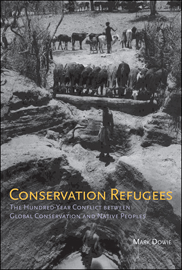
YOUNG: It’s Living on Earth, I’m Jeff Young.
For the past 100 years, the conservation movement has aimed to protect the natural world. But there’s sometimes a dark side to conservation that’s ignored – indigenous people can lose out.
Investigative journalist Mark Dowie aims to set the record straight in his new book Conservation Refugees: The Hundred-Year Conflict Between Global Conservation and Native Peoples.
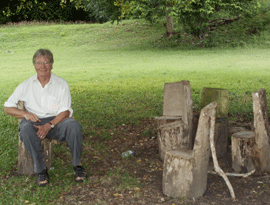
Author Mark Dowie. (Photo: Peter Poole)
DOWIE: This is an institution called conservation that is trying to do the right thing for the planet and for all of us really. I mean protecting biological diversity is essential to the future of human life, so they are good guys. They’ve just been doing it the wrong way for a hundred years. And I think now they would agree with me.
CURWOOD: So if you look at the origins of the conservation movement as you do in your book Conservation Refugees, you see that hey, this is something homegrown here in America. It comes about really with the creation of Yosemite. What happened there?
DOWIE: Yosemite National Park was formed very gradually, actually largely in a response to wilderness romantics like John Muir who in the course of arguing that Yosemite should be turned into a park basically overlooked the fact that people had been living there for 4,000 years. That fact of the matter is people, the Miwoks mainly and a couple of other tribes had been living in that area quite successfully for 4,000 years. It looked like wilderness because they weren’t fencing it and culturing it the way modern agriculture does, but they were living there and they were growing things and planting things and setting fires to keep the brush down and keep the soil rich.
But Muir decided that this was a wonderful place to rest your soul and a place for weary urbanites to leave the city for a while and think about wilderness. And of course it was. But he didn’t think they would be able to accomplish that in the company of Natives. So he arranged and argued that the Natives should be removed. He really didn’t have a lot of use for Native Americans. Although he worked with them for a while.
CURWOOD: So this was part of America’s ethnic cleansing you call it in your book.
DOWIE: Yeah, it went on from Yosemite to seven other national parks all of which were occupied by Native people. Yellowstone principally was actually occupied by seven different tribes. And the government had quite a job getting them out of Yellowstone. In fact, there was one day when the Shoshone refused to leave and the government killed 300 of them in one day to clear the park or national protected area.
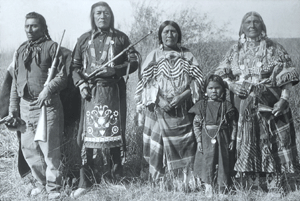
A historic photo of members of the Bannock, part of the Shoshonean tribe. (Courtesy of Yellowstone National Park)
DOWIE: Yes. Teddy Roosevelt said “The rude, fierce settler who drives the savage from the land lays all civilized mankind under a debt to him. It is of incalculable importance that America, Australia and Siberia should pass out of the hands of the red, black and yellow aboriginal owners and become the heritage of the dominant world races.”
CURWOOD: So that attitude in – what – 1904.
DOWIE: Uh-huh.
CURWOOD: … that conservation was for white Europeans and that red, black and yellow aboriginal folks were really not qualified to be stewards of their own land – sets well frankly a racist tone to the conservation movement I would say.
DOWIE: Well it does. You know when the Sierra Club supported the opening of parks around the country; a lot of the parks were posted whites only. And the Sierra Club voted to support that policy ‘til about 1920. So, yeah, I mean racism is much more shocking now than of course it was then. And you know I don’t use the word once in my book, because you really don’t have to. The story of racism tells itself in the book. And it’s quotes like that from Teddy Roosevelt that help me out in not having to use the word.
CURWOOD: So America exports its brand of conservation including ethnic attitudes. There’s an example involving the Maasai.
DOWIE: Well the Maasai, the ancient nomadic pastoral tribe that had been wandering up and down the Rift Valley for thousands of years were gradually denied their best basically watering holes and grazing places because they also happened to be watering holes and grazing places for charismatic wildlife which was a tourist draw for the countries involved, mainly Kenya and Tanzania. And it’s that denial of range and graze to a pastoral culture ultimately destroys the culture.
So you have Massai men now working as security guards in Dar es Salaam and bodyguards for brothels and that sort of life which is just not the life that they ever saw for themselves. But their cattle has been confiscated and they’ve been basically pushed off their land in the end in the interests of – punitive interests of conservation and also the interest of tourism.
CURWOOD: So the American conservation movement has been quite open about asserting that humans and wilderness are inherently incompatible. I think of the Wilderness Act that defines wilderness areas in America as being untrammeled by man, man is just a visitor. But of course one of the most important themes in your book, Mark Dowie, is that indigenous people can often do an amazing job managing the land.
DOWIE: Well that’s the irony of it, and I think its an irony that the BINGOs, the Big, International NGOs that are really controlling the conservation agenda, they’re beginning to realize that very fact that the best stewards of the land are the people who’ve been living there for a long time. There’s a lot of scientific proof of this now, a lot of correlation, map correlation, of high biodiversity and stable populations around the world.
Even in part of the developed world, people who have studied Maasai pastoral practices and traditional ecological knowledge are amazed at how well they managed their land when they had it. They knew exactly when to move their cattle out of certain areas because there were disease and disease vectors that would come in at certain times of the year. They knew to move their cattle to other graze at that time. Knew exactly when water was going to dry up and when they had to find another source of water. I mean the Rift Valley is a very challenging place to run cattle.
CURWOOD: I had the experience of going to Grand Canyon National Park here in the United States and just as I got there, maybe not too much longer afterwards, very conveniently the Hopi put on quite a dance – I think it was a rain dance or something. You write in your book that indigenous people sometimes wind up in a human zoo. How well are the indigenous folks doing in this land of ecotourism?
DOWIE: Yes. I mean some of the communities that are formed of people who have been evicted from their land and then they’re hired as tour guides and managers of the protected area, sometimes as eco-guards protecting the wildlife. And some of them make a little extra money by coming over and performing at the ecologies. And what was interesting to me – I happened to pass through an eco-lodge in Kenya while I was there. And some Massai came in and did a dance in the evening and the next day I took a walking safari with the Massai leader and I told him I’d seen this. And he said, “Well none of those guys were Maasai. Maasai won’t do that.”
[LAUGHING]
DOWIE: “… they were just tall guys that they hired in town and taught how to jump up and down to music.” I mean most indigenous people you know are aware of the fact they’re being put on show and they resent it as part of the eco-tourist package.
CURWOOD: So in terms of future international conservation efforts, what do you see as the appropriate models going forward?
DOWIE: Basically what I mentioned: models where indigenous people are involved in the conservation of the area and are allowed to stay inside the conservation area. Now if it’s gonna remain a conservation area, there may have to be a slightly altered social contract involving, for example, hunting of bush meat and what bush meat can be hunted for. No more commercial hunting of bush meat. No more commercial logging of trees. If it is going to be a protected area, it should be protected.
Most of the indigenous leaders that I interviewed around the world told me that they would be willing to return to their land, their original land, under a new contract with conservation. And involving them in the protection of biological diversity, to me is absolutely essential. And I think that’s the emerging paradigm for conservation in the world. And a lot of Conservations are beginning to agree with me.

DOWIE: Well that’s the subtext of this whole story, Steve, is the conflict between two very august sciences really: anthropology and wildlife biology, both of whom see wildlife and wilderness and land in very, very different lights. And it’s only been recently when they’ve begun to meet and talk about the interconnection between cultural diversity and biological diversity and how inseparable they are and how without one you’re not going to get the other. And I think that’s been largely the argument of the anthropologists that cultural diversity can only thrive side by side with biological diversity and vice versa.
CURWOOD: Language plays an important part of your book. And I’m struck by your comment that many indigenous groups haven no word for wilderness.
DOWIE: Yes, it’s true. I use the word a lot in interviews, and of course it translates badly into those languages. And people would be baffled – what’s he talking about, what is that word, that word’s not in our language. One Ojibway woman I was interviewing in North Canada, when her daughter who has doing the translation finally was able to through to her roughly what I was saying she started to laugh. And I said, “what’s so funny?” And her daughter said, “well the only place in the world where she’s ever seen what you’re calling wildness is in a street corner in front of the bus station in Winnipeg Manitoba.
[LAUGHING]
DOWIE: So it’s a hard concept. It’s a concept that we’re lived with for generations in the west because we value wilderness and we’ve been trying to protect wilderness and we’ve passed laws and we have huge organizations that are protecting wilderness. And most of us love it when we find and enter wilderness. But it’s not a concept that resonates with indigenous people who live in what we call wilderness but they also live off it.
CURWOOD: Mark, I’m wondering if we’re kidding ourselves to think that as humans we could be separate from what we label wilderness.
DOWIE: That’s exactly the point of the book really. We can’t. We’re part of it. We come from it. Our genes and our DNA are all derived from wilderness. And why avoid it? Why separate humans from nature? Why separate humans from wilderness?
YOUNG: Author Mark Dowie in conversation with Steve Curwood. Dowie’s book is Conservation Refugees: The Hundred-Year Conflict Between Global Conservation and Native Peoples.
[MUSIC: Jeff Stott “Saya Nova” from Six Degrees India (Six Degrees Records 2009)]
Dandy Dandelions
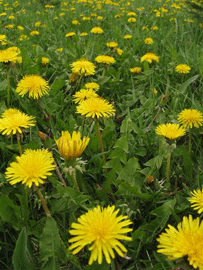
(Photo: Laurie Sanders)
YOUNG: Dandelions. For many lawn owners they’re simply the enemy. But the historic relationship between dandelions and humans is long and complex.
As far back as the 10th century, the plant was prized as both a medicine and a food. When European settlers came to America they brought dandelion seeds, helping the weed cross the Atlantic and land in your yard.
Producer Laurie Sanders visited with a biologist in Western Massachusetts who’s found new affection for this much-maligned flower.
[SOUND OF WALKING]
SANDERS: If you’re a plant biologist, one of the nice things about studying dandelions is that you don’t need a very big budget to cover travel expenses. In Joan Edwards’ case, all she needs to do is step outside the science building at Williams College.
EDWARDS: Right along here, they’ve escaped the mower there. But we’ll go around just a little further, because I think they’re out on the lawn as well as next to the building.
SANDERS: Looping around, just as she predicted, we find a patch of lawn covered in dandelions.
EDWARDS: Let’s pick one so we can look at the flower closely, [snap] and then maybe we’ll look at a developing seed head too. [snap].
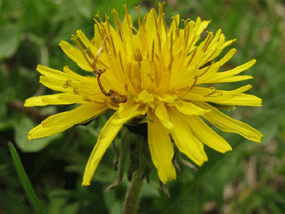
(Photo: Laurie Sanders)
EDWARDS: There’s just this most amazing thing that happens. The entire flower head, instead of being straight up, bends down to the ground, and becomes almost flat to the ground so the developing seed is actually sitting down next to the ground. And when the seeds are ready to be dispersed, that entire stalk that’s holding now the seed head, straightens and then elongates sometimes as much as twelve inches in a matter of a day or two. It’s remarkable.
SANDERS: Which is why you can mow your lawn on one day, and then the next day discover dandelion stalks -- covered with seeds -- sticking up all over your yard.
Edwards says this dance of the stem is just one of many interesting aspects of dandelion biology. Here’s another. A dandelion isn’t a single flower, but is actually composed hundreds of tiny flowers. Edwards and her students have teased the flower-heads apart and counted up to 250 flowers on a single dandelion. Each day a few flowers on the dandelion mature, with the ones on the edges blooming first and those in the center last.
But even more interesting, is that the reproductive parts of the flowers—the stamens and pistils-- are concentrated in the center of the dandelion. We can see this if we take a close look, but for a bee or other insect pollinator, those differences are obvious from a long way off. That’s because the petals that we see around the edges and the reproductive parts in the middle absorb light in the ultraviolet portion of the spectrum differently. Edwards says the reproductive parts absorb UV, but the petals on the edges don’t.
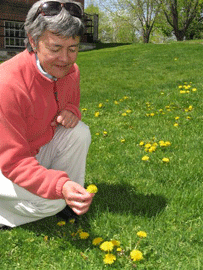
Joan Edwards sees the dandelion as much more than a weed. (Photo: Laurie Sanders)
SANDERS: A single dandelion usually takes three to four days to bloom. Within that time, insects usually visit the flowers, gathering nectar or pollen. In the process, the insect often transfers pollen from one dandelion plant to another, which promotes cross-pollination. But, Edwards says, like some other species of plants, dandelions have another way of producing seeds. A kind of evolutionary fall-back position.
EDWARDS: They don’t require cross-pollination in order to set seed. They’re what we call apomictic. So apomixis is when you can just set seed in the absence of any pollination at all. So it’s a way of selfing. So sometimes the seeds that are produced in a seed-head are really just clones of the parent plant. So that’s another very successful trait. If you happen to be an isolated dandelion and you don’t have a neighbor nearby to breed with, you just self and create seeds and there you are.
SANDERS: Once the seeds are produced, they’ll disperse over a day or two--their feathery parachutes carrying them high into the air. If all goes well for the dandelion, the seeds will land in a spot that’s suitable for germination. And in spite of what you might think, dandelions don’t grow just anywhere. They’re common in lawns and fields for a very specific reason.
EDWARDS: Dandelions are potassium hogs. They love potassium. And a lot of people use potassium fertilizer in their lawn. It’s just part of a general fertilizer mix that you would throw on your lawn.

(Photo: Laurie Sanders)
EDWARDS: And he always gets questions about what to do if people get ants in their kitchen. And he said, do you know what I tell them? I tell them to bend over and look at them carefully. And I think the same could be said for dandelions. If you bend over and look at them carefully, you’ll see just this amazing botanical, engineering marvel.
SANDERS: Although the peak of dandelion season is late spring, dandelions have been known to bloom all year long. So lawn owners still have time to get up close and personal with this common, but extraordinary flower. For Living on Earth, I’m Laurie Sanders.
[MUSIC: Chris Murphy “Dandelion rag” from Juniper (Kufala records 2005]
Related links:
- Dandelions Through the UV filter
- Biologist Joan Edwards, Williams College
- Dandelions in the Kitchen: A quick and easy dandelion recipe.
- To hear more stories by naturalist Laurie Sanders on WFCR, click here.
YOUNG: On the next Living on Earth: Cheyenne tribal law prevents coal mining under their land in Montana – but that might change.
LIMPY: The revenue that would come from that coal will address our needs for money, for education, housing for all our people.
YOUNG: Warming to coal on the reservation – next time on Living on Earth.
YOUNG: Living on Earth is produced by the World Media Foundation. Our crew includes Bobby Bascomb, Eileen Bolinsky, Bruce Gellerman, Ingrid Lobet, Helen Palmer, Jessica Ilyse Smith, Ike Sriskandarajah, and Mitra Taj, with help from Sarah Calkins, Marilyn Govoni, and Sammy Souza. Our interns are Annie Glausser and Lisa Song. Jeff Turton is our technical director. Alison Lirish Dean composed our themes. Our executive producer is Steve Curwood. And you can find us anytime at loe.org.
I’m Jeff Young. Thanks for listening
Living on Earth wants to hear from you!
Living on Earth
62 Calef Highway, Suite 212
Lee, NH 03861
Telephone: 617-287-4121
E-mail: comments@loe.org
Newsletter [Click here]
Donate to Living on Earth!
Living on Earth is an independent media program and relies entirely on contributions from listeners and institutions supporting public service. Please donate now to preserve an independent environmental voice.
NewsletterLiving on Earth offers a weekly delivery of the show's rundown to your mailbox. Sign up for our newsletter today!
 Sailors For The Sea: Be the change you want to sea.
Sailors For The Sea: Be the change you want to sea.
 The Grantham Foundation for the Protection of the Environment: Committed to protecting and improving the health of the global environment.
The Grantham Foundation for the Protection of the Environment: Committed to protecting and improving the health of the global environment.
 Contribute to Living on Earth and receive, as our gift to you, an archival print of one of Mark Seth Lender's extraordinary wildlife photographs. Follow the link to see Mark's current collection of photographs.
Contribute to Living on Earth and receive, as our gift to you, an archival print of one of Mark Seth Lender's extraordinary wildlife photographs. Follow the link to see Mark's current collection of photographs.
 Buy a signed copy of Mark Seth Lender's book Smeagull the Seagull & support Living on Earth
Buy a signed copy of Mark Seth Lender's book Smeagull the Seagull & support Living on Earth

